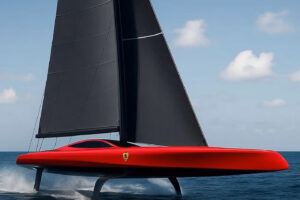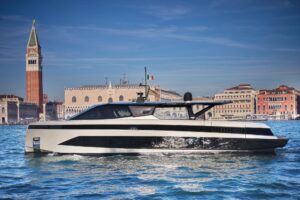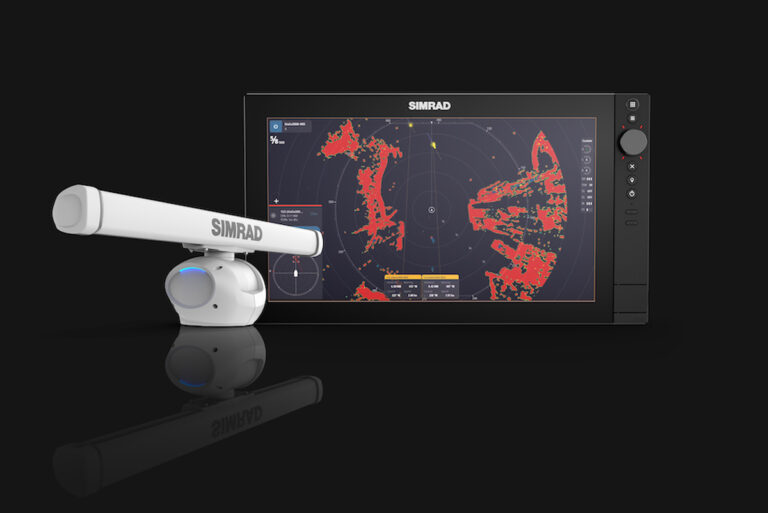
Design: Perini Navi 40-Meter Cutter
Like a fine vintner honing her skills through practice, education and instinct, Perini Navi continues to improve the performance of its sailing yachts, and does so without abandoning the quality and luxury that made the yard’s reputation. This 40-meter cutter, designed in collaboration with Ron Holland, perfectly illustrates the builder’s philosophy (view the complete photo gallery).
Perhaps the most extreme yacht Perini Navi has built is the 38-meter (125 feet) P2, designed by Philippe Briand and launched in 2008. By the builder’s standards, her deckhouse has an ultralow profile, a racy sloop rig and a deliciously modern décor belowdecks. Her relatively light displacement (344,000 pounds vs. 485,000 pounds for the 40-meter) and nearly plumb stem broadcast her aspirations for speed.
Holland’s design, on the other hand, strikes a more traditional pose. He extended the datum waterline (DWL) to give the yacht a good turn of speed, which gives her a more upright stem than you’ll see on traditional Perinis, but it’s far from being as extreme as that of P2. In addition to increasing the 40-meter’s displacement speed, the increase in DWL has allowed Holland to draw finer waterlines in the forward sections, decreasing resistance and easing motion in a seaway. Firm sections amidships enhance the hull’s form stability. These sections transition to what Holland describes as low-resistance stern lines, which encourage the water to clear the run, and this in turn reduces wave-making resistance. The yacht’s high-aspect-ratio centerboard will give her the pointing ability we expect from modern sailing yachts.
Only a sharp plumb stem would appear more aggressive than this yacht’s straight raked stem, and maybe only a counter stern by W. Starling Burgess would be more graceful. As drawn, these angles work well together, perfectly suiting the yacht’s persona. If she were human, she’d be a tough CEO with a soft spot for underprivileged citizens. The subtlest of springy sheer lines, like a taut catenary, connects the ends.
The superstructure grows from the deck as a rock uncovered by the surf stands clear of the sand on an empty beach. The leading edge of what would qualify as a trunk cabin if it had portlights rises ever so gradually from the foredeck and continues the climb until it meets the front of the pilothouse. An eye-level view of the profile suggests that the angle of rake at the leading edge of the trunk cabin and the rake of the windows in the pilothouse successfully mimic one another. Careful comparison of the angles formed by the raked transom, cockpit coaming and flying buttress at the after end of the house lead me to believe they are the same. These angles perform as a unit, artistically balancing the composition, but they should have the same effect on us when we see the 40-meter under way in three dimensions — I’ll wager that our impression of harmony will remain.
Unlike many yachts this size, which use the cavernous space under the afterdeck to stow the tender, Perini Navi’s yacht devotes the area to stowage and machinery. The transom opens to become a teak-covered beach with wide steps leading to and from the afterdeck. The tender lives in a compartment beneath the forward end of the trunk cabin, which is over the crew’s quarters.
Although owners of Perini Navis love these yachts for their stately progress through the water and superb comfort belowdecks, some of the builder’s clients need the occasional rush of adrenaline to accompany the luxury. They can expect that from the 40-meter.
LOA: 129’4″
LWL: 111’11”
BEAM: 30’9″
DRAFT: 11’6″ (keel up)
and 29’6″ (keel down)
DISPL.: 485,000 lb.
SAIL AREA: 12,529 sq. ft.
ENGINE: 1 x 738 hp Caterpillar C18
FUEL: 3,100 gal.
WATER: 1,320 gal.
Perini Navi, 401-683-5600; www.perininaviusa.com









